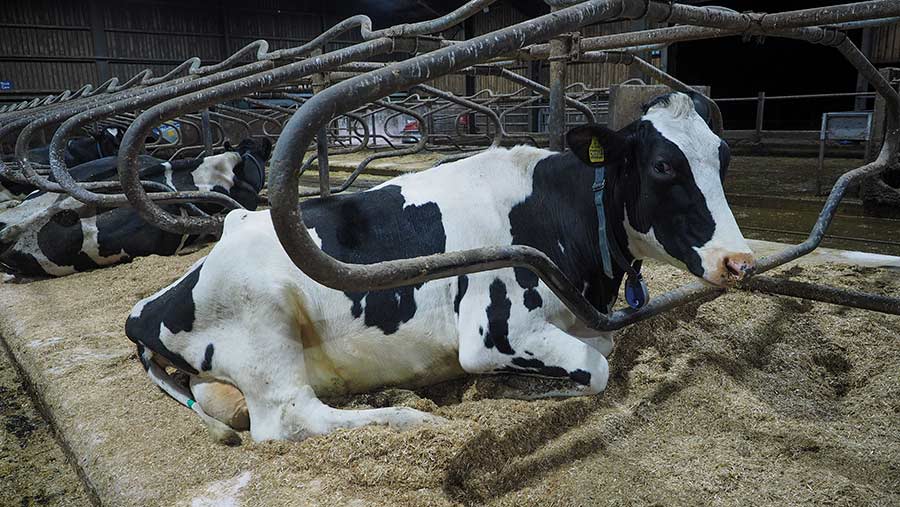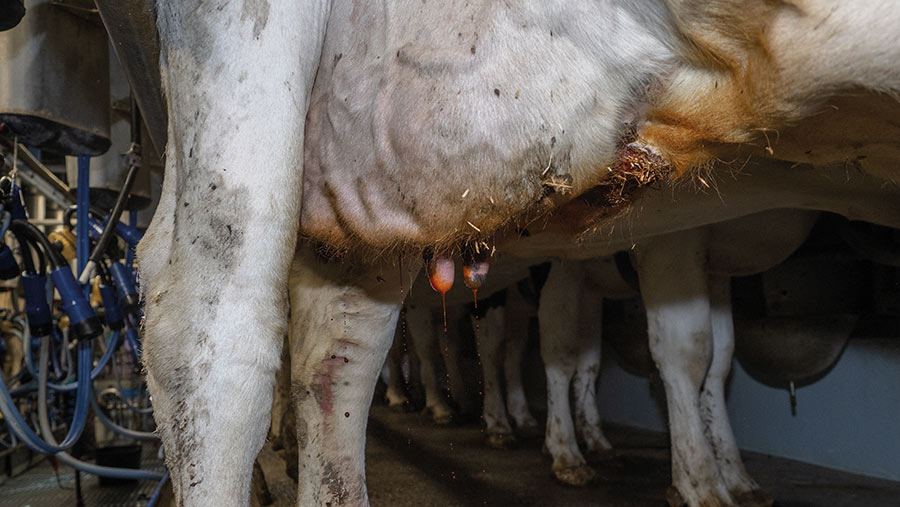5 ways to build on improvements in udder health
 © Kathy Horniblow
© Kathy Horniblow Improved environmental management, protocols and breeding for udder health have combined to help lower mastitis rates and antibiotics use.
However, farmers could make bigger strides with improved recording of mastitis infections.
The National Milk Records (NMR) 500 Report (see box on udder health improvements) highlights a median mastitis incidence of 28 cases in every 100 cows in 2020 – a reduction of eight cases a year from 2016. Somatic cell counts (SCC) have also declined.
Vet Charlie Neale from Shepton Vets says mastitis rates have reduced across the industry in the past decade.
But a range in performance between farms underlines the scope for improvement on some dairy farms. Across his practice, the lowest incidence is 1.5 cases for every 100 cows while the highest is more than 100%.
See also: 4 ways a robotic dairy got mastitis under control
The NMR 500 Report sets a target of 18 cases for every 100, but Mr Neale is quick to highlight the need to set farm-specific targets. Many farms will be able to achieve far lower, he says.
For every case of mastitis, he advises recording cow ID, quarter affected, first case or repeat in that quarter, stage of lactation, any historic SCC issue and treatment and withdrawal periods.
To help drive down mastitis rates further, he suggests looking at five areas.
1. Milking cow environment
Farmers are now less accepting of dirty cows and more aware of cow comfort. This is one reason mastitis rates have declined. Passageways have also tended to get wider, helping cow cleanliness.
Top tips
- Maintain a comfortable place for cows to lie so they are not standing and making the beds dirty
- Maintain cubicle beds twice daily by removing any muck, raking over and applying new bedding
- If there is a big wave of slurry every time the automatic scrapers run, they’re not running frequently enough

© Kathy Horniblow
2. Dry cow environment
Use of teat sealants has reduced the incidence of mastitis in the dry period. However, the dry cow environment is one of the most variable areas Mr Neale sees on farm.
Top tips
- Avoid overstocking and provide a clean bedding environment
- Cow kept outside need to be loosely stocked and kept on clean, fresh pasture that’s rested regularly
- Aim for 11 cubicles for every 10 cows
- When on loose straw yards, provide 10sq m of lying space, straw up daily and clean out every other week
3. Milking routine
There’s much more diligence in the parlour, partly because of milk buyers’ requirements. Training and protocols have also improved.
Top tips
- Strip the fore milk at every milking. This is a legal requirement and should also help with mastitis prevention
- Use dedicated pre-milking and post-milking disinfectants. A pre-milking disinfectant should provide a rapid kill; a post-milking one should have long-term disinfection properties and good teat-conditioning qualities
- Attach the unit 60sec after stripping for optimal milk let-down. This may need to be 90-120sec on a three-times-a-day milking system
- Good milk let-down will help teat condition and vacuum stability, which can reduce mastitis risk
4. Drying-off technique
A big uptake of selective dry cow therapy has focused farmers’ attention on udder health and infusion technique at drying-off to avoid the introduction of bacteria.
Top tips
- Find a way to dry off cows that reduces the chance of contamination from tails or feet,
for example, by using a rollover crush - Wear a clean pair of gloves for each cow
- Disinfect front teats first (working front to back) and then infuse in the opposite order
5. Drying-off decisions
Top tips
- Work with your vet to set thresholds for when cows should receive a sealant but no antibiotics at drying-off. This will depend on bulk milk SCC, cow temperament, cow history and teat condition
- For example, a herd with a bulk milk SCC of >300,000 cells/ml will likely need to use antibiotics on most cows. If the bulk SCC is <100,000 cells/ml, antibiotics will rarely need to be used
Udder health improvements
The NMR 500 Report results are from a study of herd performance in 500 Holstein/Friesian, NMR-recorded herds for the year ending August 2020, carried out by the University of Reading.
Since 2016 a subset of the 500 herds has been included for analysis of mastitis incidence.
Only half of the 500 herds record sufficient mastitis incidence data in milk records for it to be used in the analysis.
Key results
- 28 cases in every 100 cows – the mastitis incidence in the median herd (middle herd) of the 2020 subset – a reduction of eight cases for every 100 cows a year from 2016
- 18 cases in every 100 cows – the target level for mastitis cases which is achieved or bettered by the best 25% of herds. One in four of the 500 herds achieved this level or better
- 81% of cows recorded no mastitis in the lactation in half the herds with mastitis records – an increase from 79% in 2016
- In half the herds nearly 50% of the cows completed lactations without recording a high SCC
- 66% of the 500 herds had a herd SCC of under 200,000 cell/ml in 2020, compared with 44% in 2010
Case study: Rodway Farm, Bridgwater & Taunton College
Farm facts
- 240 pedigree Holsteins
- 10,000 litres a cow a year at 4.2% fat and 3.3% protein
- Housed and calving all year round
- Milked twice a day through 24:24 herringbone parlour
- Milk supplied to Muller Tesco
Attention to cow comfort and hygiene has helped reduce the number of mastitis cases at Rodway Farm at Bridgwater & Taunton College in Somerset from 45 cases for every 100 cows in 2018/19 to 18 in every 100 cows in 2021.
Mastitis cases are now generally less severe and respond to non-steroidal anti-inflammatory drugs (NSAIDs) and regular stripping.
On-farm mastitis bacterial cultures are grown, and antibiotics are only used on gram-positive bacteria that respond better.
No cows have been treated with antibiotics for mastitis since June.
Herd manager Bryan Carter and his team have focused on five areas, with support from vet Bibby Thomas at Shepton Vets:
- Upgrading the mattresses and cubicles
Old mattresses have been upgraded to comfortable, foam-covered mattresses and a cranked-neck rail has been installed. Cows now lie down more quickly, and as they walk around less frequently there’s less risk of slurry being splashed on to feet and legs - Moving to straw bedding
To address rising costs and inconsistency in bedding quality, the farm has swapped from sawdust to tub-ground straw, which has proved very absorbent - Installing automatic scrapers and paying attention to cow cleanliness
Automatic scrapers have been installed to replace twice-daily tractor scraping. These now run every hour. Cows’ tails are also trimmed, and udders are singed more frequently - Changing the cluster unit
Mr Carter believes changing the cluster units to include triangle liners with bleed holes has had a dramatic impact on mastitis incidence. The units are now lighter, so they milk out better and aid cow comfort. Milk is also drawn away from the teat end quickly and there’s less teat damage - Bed management
Any slurry or moisture 45-50cm off the heel stone is brushed off twice a day and disinfectant powder is applied. A dispenser is then used to top up the straw.

